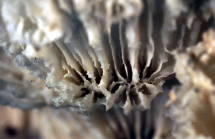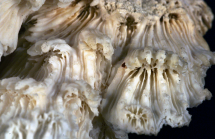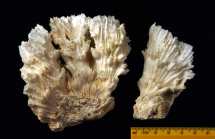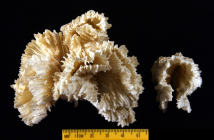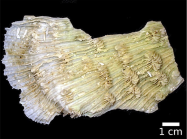
| Intro | | About | | Wiki | | Search traits | | Data explorer | | Literature | | Definitions | | Sources | | Webservices | | Statistics | | Feedback | | Editors | | Log in |
WoRMS taxon detailsMycedium Milne Edwards & Haime, 1851
203844 (urn:lsid:marinespecies.org:taxname:203844)
accepted
Genus
Madrepora elephantotus Pallas, 1766 accepted as Mycedium elephantotus (Pallas, 1766) (type by subsequent designation)
Leptoseris (Mycedium) Milne Edwards & Haime, 1851 · unaccepted > superseded combination
Mycedium Oken, 1815 · unaccepted > unavailable name
Phyllastraea Dana, 1846 · unaccepted > junior subjective synonym
marine,
Milne Edwards H, Haime J. (1851). Recherches sur les polypiers. Mémoire 6. Monographie des Fongides. <em>Annales des Sciences Naturelles, Zoologie, Series 3.</em> 15: 73-144. [details]
Description 'Polypier en expansions frondiformes. Calices circonscrits, penchés, submamillaires, et disposés autour de l'individu...
Description 'Polypier en expansions frondiformes. Calices circonscrits, penchés, submamillaires, et disposés autour de l'individu parent qui reste plus développé que les autres. Plateau commun nu et costulé.' (Milne Edwards and Haime, 1851, vol. 15: 130) [details] Status Mycedium was originally described by Oken (1815). According to ICZN Opinion 417 (September 1956), the names originally...
Status Mycedium was originally described by Oken (1815). According to ICZN Opinion 417 (September 1956), the names originally proposed by Oken (1815) are rejected. Therefore authorship is assigned to the second person who used the name. The holotype of Madrepora elephantotus Pallas, 1766, p. 290, is lost (Chevalier, 1975, p. 338). [details]
Hoeksema, B. W.; Cairns, S. (2025). World List of Scleractinia. Mycedium Milne Edwards & Haime, 1851. Accessed through: World Register of Marine Species at: https://www.marinespecies.org/aphia.php?p=taxdetails&id=203844 on 2025-05-06
Date action by 2006-09-25 06:54:45Z changed Martinez, Olga
Nomenclatureoriginal description
Milne Edwards H, Haime J. (1851). Recherches sur les polypiers. Mémoire 6. Monographie des Fongides. <em>Annales des Sciences Naturelles, Zoologie, Series 3.</em> 15: 73-144. [details] original description (of Phyllastraea Dana, 1846) Dana, J.D. (1846-1849). Zoophytes. United States Exploring Expedition during the years 1838-1842. <em>Lea and Blanchard, Philadelphia.</em> 7: 1-740, 61 pls. (1846: 1-120, 709-720; 1848: 121-708, 721-740; 1849: atlas pls. 1-61)., available online at https://www.biodiversitylibrary.org/page/18989497, http://www.sil.si.edu/digitalcollections/usexex/navigation/ScientificText/USExEx19_08select.cfm [details] original description (of Mycedium Oken, 1815) Oken, L. (1815-1816). Lehrbuch der Naturgeschichte. Dritter Theil: Zoologie. <em>Erste Abtheilung: Fleischlose Thiere,Leipzig: C.H. Reclam & Jena: A. Schmid, [book (3rd vol part one, of 3 vols, including plates atlas of T.1, 1813].</em> xxviii + 842 pp. + xviii, 40 pls. L [copepods 180-184, 357-359, 4 plates]., available online at https://doi.org/10.5962/bhl.title.166403 [details] basis of record Veron JEN. (1986). Corals of Australia and the Indo-Pacific. <em>Angus & Robertson Publishers.</em> [details] Otheradditional source
Veron JEN, Pichon M. (1980). Scleractinia of Eastern Australia – Part III. Family Agariciidae, Siderastreidae, Fungiidae, Oculinidae, Merulinidae, Mussidae, Pectinidae, Caryophyllidae, Dendrophylliidae. <em>Australian Institute of Marine Science Monograph Series.</em> 4: 1-459. [details]
additional source Veron JEN. (2000). Corals of the World. Vol. 1–3. <em>Australian Institute of Marine Science and CRR, Queensland, Australia.</em> [details] additional source Wells JW. (1936). The nomenclature and type species of some genera of recent and fossil corals. <em>American Journal of Science.</em> 31: 97-134., available online at https://ajsonline.org/article/61464 [details] additional source Yabe H, Sugiyama T. (1935). Revised list of the reef-corals from the Japanese seas and of the fossil reef corals of the raised reefs and the Ryukyu limestone of Japan. <em>Journal of the Geological Society of Japan.</em> 42: 379-403. page(s): 382, 389, 396 [details] additional source Huang D, Benzoni F, Fukami H, Knowlton N, Smith ND, Budd AF (2014) Taxonomic classification of the reef coral families Merulinidae, Montastraeidae, and Diploastraeidae (Cnidaria: Anthozoa: Scleractinia). Zoological Journal of the Linnean Society 171: 277–355., available online at https://doi.org/10.1111/zoj.12140 [details] additional source Duncan PM (1884) A revision of the families and genera of the sclerodermic Zoantharia, Ed. & H., or Madreporaria (M. Rugosa excepted). Journal of the Linnean Society of London, 18: 1-204. [details] additional source Verrill A. E. (1901). Variations and nomenclature of Bermudian, West Indian and Brazilian reef corals, with notes on various Indo-Pacific corals. <em>Transactions of the Connecticut Academy of Arts and Sciences.</em> 11: 63-168., available online at https://www.biodiversitylibrary.org/page/13464046 [details] additional source Duerden, J. E. (1898). On the relations of certain Stichodactylinae to the Madreporaria. Journal of the Linnean Society of London (Zoology), 26, 635-653 page(s): 638 [details] additional source Dunn, D. F. (1982). Cnidaria. McGraw-Hill Book Company. New York and other cities., volume 1, pp. 669-706 page(s): 702 [details] additional source Neave, Sheffield Airey. (1939-1996). Nomenclator Zoologicus vol. 1-10 Online. <em>[Online Nomenclator Zoologicus at Checklistbank. Ubio link has gone].</em> , available online at https://www.checklistbank.org/dataset/126539/about [details]  Present Present  Inaccurate Inaccurate  Introduced: alien Introduced: alien  Containing type locality Containing type locality
From editor or global species database
Comparison Organically united corallites appear to have independently evolved twice, within Merulinidae in Mycedium + Pectinia, and within Lobophylliidae in Echinophyllia + Oxypora (Budd et al., 2012: fig. 2B). Other synapomorphies of the Mycedium + Pectinia clade are polymorphic corallites, extensive coenosteum, unequal costosepta thickness, discontinuous columellae (lamellar linkage), not more than 6 teeth per septum, interarea made up of horizontal bands, and micro-fibrous deposits. Transverse crosses are also lost in this lineage. The clade is highly supported. Mycedium and Pectinia share all morphological traits examined here, as opposed to the paraphyletic Pectinia recovered by molecular data. Physophyllia is also extremely similar on the basis of macromorphology. The lack of distinction between these three genera, and the paraphyly of Pectinia may be grounds for regarding Mycedium as a synonym of Pectinia and/or Physophyllia, but as Mycedium elephantotus remains the only species placed on the morphology tree, no changes are proposed here. Note that quantitative measurements were based on peripheral corallites as structures of the central corallite may be extremely large in comparison. [details]Description 'Polypier en expansions frondiformes. Calices circonscrits, penchés, submamillaires, et disposés autour de l'individu parent qui reste plus développé que les autres. Plateau commun nu et costulé.' (Milne Edwards and Haime, 1851, vol. 15: 130) [details] Diagnosis Colonial, with intracalicular budding only. Corallites polymorphic and organically united; monticules absent. Coenosteum costate, extensive amount (≥ corallite diameter). Calice width medium (4–15 mm), with medium relief (3–6 mm). Costosepta confluent. Septa in 3 cycles (24–36 septa). Free septa present but irregular. Septa spaced < 6 septa per 5 mm. Costosepta unequal in relative thickness. Columellae trabecular and spongy (> 3 threads), < 1/4 of calice width, and discontinuous among adjacent corallites (lamellar linkage). Paliform (uniaxial) lobes weak or moderate. Epitheca absent and endotheca abundant (vesicular). Tooth base at mid-calice circular. Tooth tip at mid-calice irregular; tip orientation perpendicular to septum. Tooth height medium (0.3–0.6 mm) and tooth spacing medium (0.3–1 mm), with no more than 6 teeth per septum. Granules scattered on septal face; irregular in shape. Interarea formed by horizontal bands. Walls formed by dominant paratheca; abortive septa absent. Thickening deposits micro-fibrous. Costa center clusters not distinct; medial lines strong. Septum center clusters not distinct; medial lines strong. Transverse crosses absent. Columella centers clustered. [details] Remark This genus has commonly been regarded to be similar to Echinophyllia (Lobophylliidae), because of its laminar growth form (Vaughan and Wells, 1943: 198; Wells, 1956: F419; Veron and Pichon, 1980: 319; Veron, 1986: 382; Veron, 2000, vol. 2: 342). The lack of distinct corallite walls, or corallites being 'organically united' (Vaughan and Wells, 1943: 196), is a distinguishing feature of Pectiniidae, the family in which Mycedium and Echinophyllia were placed prior to revision by Budd et al. (2012). It is now clear based on molecular phylogenetics that this genus is closest to and also nested within Pectinia de Blainville, 1825: 201 (Fukami et al., 2008; Huang et al., 2011, 2014; Huang, 2012; Arrigoni et al., 2012). [details] Status Mycedium was originally described by Oken (1815). According to ICZN Opinion 417 (September 1956), the names originally proposed by Oken (1815) are rejected. Therefore authorship is assigned to the second person who used the name. The holotype of Madrepora elephantotus Pallas, 1766, p. 290, is lost (Chevalier, 1975, p. 338). [details] Type designation Subsequent designation by Verrill (1901) [details] |
